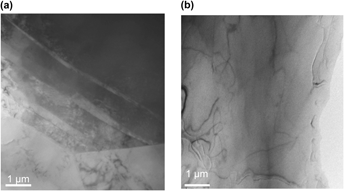Crossref Citations
This article has been cited by the following publications. This list is generated based on data provided by
Crossref.
Bian, Ming Zhe
Zeng, Zhuo Ran
Xu, Shi Wei
Zhu, Su Ming
Zhu, Yu Man
Davies, Christopher Huw John
Birbilis, Nick
and
Nie, Jian Feng
2016.
Improving Formability of Mg–Ca–Zr Sheet Alloy by Microalloying of Zn .
Advanced Engineering Materials,
Vol. 18,
Issue. 10,
p.
1763.
Hase, Takayuki
Ohtagaki, Tatsuya
Yamaguchi, Masatake
Ikeo, Naoko
and
Mukai, Toshiji
2016.
Effect of aluminum or zinc solute addition on enhancing impact fracture toughness in Mg–Ca alloys.
Acta Materialia,
Vol. 104,
Issue. ,
p.
283.
Suh, Byeong-Chan
Kim, Jae H.
Hwang, Ji Hyun
Shim, Myeong-Shik
and
Kim, Nack J.
2016.
Twinning-mediated formability in Mg alloys.
Scientific Reports,
Vol. 6,
Issue. 1,
Chino, Yasumasa
Huang, Xinsheng
and
Suzuki, Kazutaka
2017.
Development of Room Temperature Formability of Rolled Magnesium Alloy Sheets by Texture Control.
Journal of the Japan Institute of Metals and Materials,
Vol. 81,
Issue. 2,
p.
49.
CHINO, Yasumasa
2017.
Research and Development on High Performance of Wrought Magnesium Alloys by Plastic Forming.
Journal of the Japan Society for Technology of Plasticity,
Vol. 58,
Issue. 683,
p.
1074.
Noguchi, Tomoyuki
Suzuki, Kazutaka
Huang, Xinsheng
Saito, Naobumi
Tsukada, Yuhki
Koyama, Toshiyuki
and
Chino, Yasumasa
2018.
Effects of Calcium Concentration on Room Temperature Formability and Damping Properties of Rolled Mg-Ca Alloys.
Journal of the Japan Institute of Metals and Materials,
Vol. 82,
Issue. 7,
p.
249.
Jang, Hyo-Sun
Seol, Donghyuk
and
Lee, Byeong-Joo
2019.
Modified embedded-atom method interatomic potential for the Mg–Zn–Ca ternary system.
Calphad,
Vol. 67,
Issue. ,
p.
101674.
Xu, Li
Xiang, Minghua
Wang, Jun
Zhang, Jun
Wang, Chenning
and
Xie, Chao
2020.
Analysis and Characterization on Dynamic Recrystallization in Casting AZ31 Mg Alloys Under Plane Strain Compression.
Materials,
Vol. 13,
Issue. 3,
p.
522.
Ishiguro, Yuya
Huang, Xinsheng
Tsukada, Yuhki
Koyama, Toshiyuki
and
Chino, Yasumasa
2020.
Calculated Grain Boundary Segregation in Mg-Zn-Ca Alloys and Its Correlation to the Texture Formation and Formability of the Alloys.
Journal of the Japan Institute of Metals and Materials,
Vol. 84,
Issue. 10,
p.
318.
Xia, Nan
Wang, Cheng
Gao, Yipeng
Hua, Zhen-Ming
Ma, Chen-Yi
Du, Chun-Feng
Zhang, Hang
Zhang, Hong-Min
Li, Mei-Xuan
Zha, Min
and
Wang, Hui-Yuan
2021.
Enhanced ductility of Mg–1Zn–0.2Zr alloy with dilute Ca addition achieved by activation of non-basal slip and twinning.
Materials Science and Engineering: A,
Vol. 813,
Issue. ,
p.
141128.
Fukuoka, Hitoshi
Huang, Xinsheng
Suzuki, Kazutaka
Tsukada, Yuhki
Koyama, Toshiyuki
and
Chino, Yasumasa
2021.
Effect of Rolling Temperature on Room Temperature Formability and Texture Formation of Mg-3 mass%Al-1 mass%Sn Alloy Sheet.
Journal of the Japan Institute of Metals and Materials,
Vol. 85,
Issue. 3,
p.
120.
Sanyal, Souriddha
Bhuyan, Pallabi
Bandyopadhyay, Tapas K.
and
Mandal, Sumantra
2022.
Multiscale precipitate evolution and its implications on the tensile deformation behavior in thermomechanically processed and peak-aged lean Mg-Al-Ca-Mn alloy.
Materialia,
Vol. 26,
Issue. ,
p.
101566.
Jang, Hyo-Sun
Lee, Jong-Kwan
Tapia, Antonio João Seco Ferreira
Kim, Nack Joon
and
Lee, Byeong-Joo
2022.
Activation of non-basal <c + a> slip in multicomponent Mg alloys.
Journal of Magnesium and Alloys,
Vol. 10,
Issue. 2,
p.
585.
Shi, B.Q.
Zhang, R.D.
Shang, X.L.
Wang, Y.Z.
Long, T.
Jiang, J.M.
Li, C.Q.
and
Liu, B.Y.
2023.
Reducing mechanical anisotropy by formation of symmetrical ring-like texture via final-pass heavy reduction rolling in Mg alloy.
Journal of Materials Research and Technology,
Vol. 24,
Issue. ,
p.
4315.
 $\bf\left\{ {10\bar 12} \right\}$ twins in the rolled Mg–Zn–Ca alloy with high formability
$\bf\left\{ {10\bar 12} \right\}$ twins in the rolled Mg–Zn–Ca alloy with high formability
 $\left\{ {10\bar 12} \right\}$ twins and local fine-grained microstructures were formed. It is therefore suggested that the fine twins induce this local fine-grained microstructure, which become the nuclei for recrystallization during annealing. As a result, the intensity of the basal texture is reduced. Calculations revealed that the
$\left\{ {10\bar 12} \right\}$ twins and local fine-grained microstructures were formed. It is therefore suggested that the fine twins induce this local fine-grained microstructure, which become the nuclei for recrystallization during annealing. As a result, the intensity of the basal texture is reduced. Calculations revealed that the  $\left\{ {10\bar 12} \right\}$ twinnability is enhanced by the addition of Ca because of the increased unstable stacking fault energy (γus) and decreased unstable twin fault energy (γut).
$\left\{ {10\bar 12} \right\}$ twinnability is enhanced by the addition of Ca because of the increased unstable stacking fault energy (γus) and decreased unstable twin fault energy (γut).

